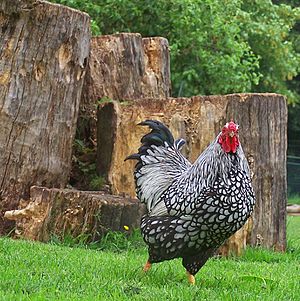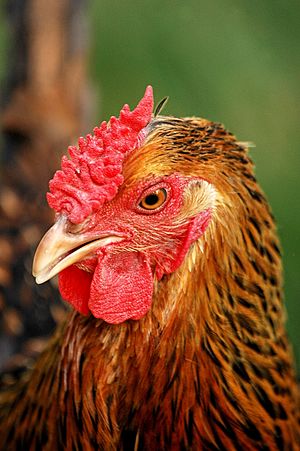Wyandotte chicken facts for kids

The silver-laced is the original variety of the breed.
|
|
| Conservation status | Not at risk |
|---|---|
| Other names | American Sebright (before 1883) |
| Country of origin | United States |
| Use | Dual-purpose |
| Traits | |
| Weight |
|
| Skin color | Yellow |
| Egg color | Brown |
| Comb type | Rose |
| Classification | |
| APA | American |
| EE | yes |
| PCGB | Soft Feather: Heavy |
|
|
The Wyandotte is a special kind of chicken that first appeared in the United States in the 1870s. It got its name from the Wyandot people, a group of Native Americans. Wyandottes are known as a "dual-purpose" breed. This means they are good for two things: laying brown eggs and providing yellow-skinned meat. They are also very popular as show birds because they come in many beautiful colors. Before they were called Wyandottes, they were known as the American Sebright.
Contents
History of the Wyandotte Chicken
The Wyandotte chicken was created in the United States around the 1870s. Four people, H. M. Doubleday, John Ray, L. Whittaker, and Fred Houdlette, helped make this breed. The very first type was the silver-laced Wyandotte. This type was officially recognized in 1883 and soon after, it was brought to Britain.
How the Wyandotte breed started is a bit of a mystery. However, two important chicken breeds, the silver spangled Hamburg and the dark Brahma, were likely used to create it. The Hamburg chicken helped give the Wyandotte its unique rose comb. The Brahma chicken helped create its color patterns. Before being officially named, people sometimes called them "Sebright Cochin" or "American Sebright."
Over time, new colors of Wyandottes appeared:
- The gold-laced Wyandotte came from mixing silver-laced hens with gold-spangled Hamburg and partridge Cochin roosters.
- The white Wyandotte was a natural change (called a "sport") from the silver-laced type.
- The buff Wyandotte was created by crossing silver-laced chickens with buff Cochin chickens.
- The black Wyandotte was also a natural change from both the silver-laced and gold-laced types.
- The partridge Wyandotte came from mixing gold-laced chickens with other breeds like Indian Game, partridge Cochin, and gold-pencilled Hamburghs.
- The Columbian Wyandotte was a lucky accident! It happened when white Wyandottes were crossed with barred Plymouth Rock birds. It was named after the World's Columbian Exposition in Chicago, Illinois, in 1893.
Smaller versions of the Wyandotte, called bantams, were officially recognized in 1933.
In 2015, a group called the American Livestock Conservancy said the Wyandotte was "recovering." By 2016, it was doing so well that it was no longer considered in danger. In Germany, it is still listed as "alert" on a special list for old and endangered farm animals.
What Wyandottes Look Like
Wyandottes are fairly large chickens, but they are compact and have a rounded shape. They usually weigh between 5.5 and 8.5 pounds. Their chest is deep, full, and well-rounded. Their body is medium in length but very wide, and this width continues across their back to their tail. They have clean legs (no feathers on their legs) and feathers that lie close to their body. They also have a wide head with a special type of comb called a rose comb. Their skin and legs are yellow, and their earlobes, face, and wattles (fleshy growths under their chin) are red.
Sometimes, silver-laced Wyandotte roosters might have feathers that look like a hen's feathers.
Wyandotte Colors
In the United States, the American Poultry Association officially recognizes nine different colors for Wyandottes:
- Black (recognized in 1893)
- Blue (1977)
- Buff (1893)
- Columbian (1905)
- Golden Laced (1888)
- Partridge (1893)
- Silver Laced (1883)
- Silver Pencilled (1902)
For the smaller bantam Wyandottes, the same nine colors are recognized, plus an extra one called buff Columbian.
In Canada, a famous breeder named John Strickler Martin raised and sold White Wyandotte chickens from his farm. His chickens often won awards and were very popular.
In Europe, a group called the Entente Européenne lists thirty different colors for Wyandottes! The Poultry Club of Great Britain recognizes many colors, including barred, black, blue, blue-laced, blue partridge, buff, buff-laced, Columbian, gold-laced, partridge, red, silver-laced, silver-pencilled, and white.
How Wyandottes Are Used
The Wyandotte is a "dual-purpose" chicken breed. This means people raise them for two main reasons:
- Eggs: Hens lay a good number of tinted (light brown) eggs. They start laying eggs fairly quickly.
- Meat: They are also raised for their meat.
Wyandottes are also very popular as show birds, especially in Germany, because of their beautiful appearance and many color varieties.



